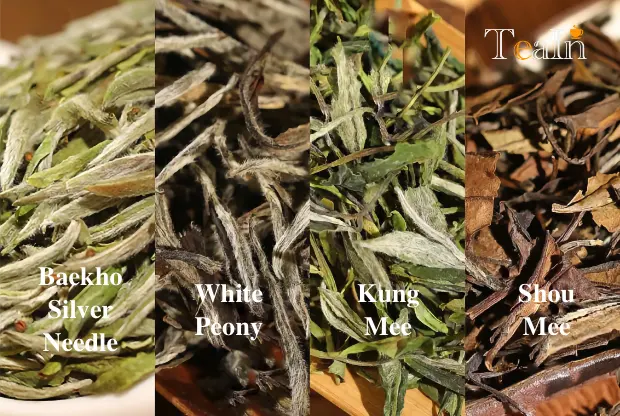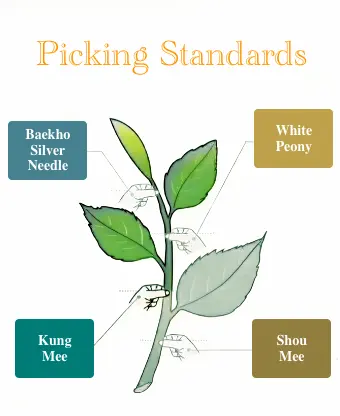The Classifications and Brewing Methods of White Tea

White tea is a unique and enchanting variety of tea with a rich history and numerous qualities. Originating mainly from China, it is known for its delicate flavor and subtle aroma.
White tea is made from tender tea leaves and buds that are minimally processed, often through withering and drying. This gentle processing method helps retain the natural essence and health benefits of the tea.
White tea is rich in antioxidants, which can help protect the body from oxidative stress and reduce the risk of chronic diseases. It also has a soothing effect on the digestive system and can calm the mind.
Whether enjoyed on its own or paired with light snacks, white tea offers a refreshing and delightful experience. Its elegance and simplicity make it a favorite among tea lovers around the world.
White tea is mainly divided into four categories:Baekho Silver Needle (Baihao Yinzhen), White Peony (Bai Mudan), Kung-Mee (Gongmei), Shou-Mee (Shoumei).

I. Baekho Silver Needle (Baihao Yinzhen)
Characteristics:
- Appearance: Plump and straight, covered with fine white hairs, looking like silver and snow.
- Raw material: It is made from single buds and is considered the top grade of white tea.
Taste:
- It has a fresh, mellow, and refreshing taste with a strong fragrance of fine hairs.
- The taste is light with an obvious sweet aftertaste.
Brewing methods:
- Cup brewing: Put an appropriate amount of Baekho Silver Needle into a cup and brew it with hot water at 85℃ - 90℃. It can be drunk after a short while. You can also enjoy the graceful posture of the tea leaves standing upright in the water.
- Gaiwan (covered bowl) brewing: Place Baekho Silver Needle in a gaiwan, rinse it with hot water and then pour out the water. Then brew it with water at around 90℃. The first infusion should be quickly poured out, and then the brewing time can be appropriately extended according to personal taste.
- Boiling method: This is suitable for aged Baekho Silver Needle. Put an appropriate amount of Baekho Silver Needle into a boiling pot, add cold water, bring it to a boil, and then turn to low heat and boil for a few more minutes. The brewed tea soup is mellow with a rich fragrance of fine hairs.
II. White Peony (Bai Mudan)
Characteristics:
- Appearance: The green leaves are interspersed with silver-white hairy buds, resembling a flower. After brewing, the green leaves hold the tender buds, just like a budding flower.
- Raw material: It is made from one bud with one or two leaves.
Taste:
- It has a mellow and sweet taste that is refreshing.
- The floral fragrance is obvious and long-lasting.
Brewing methods:
- Cup brewing: Brew it with hot water at around 90℃ and you can enjoy the beautiful shape of White Peony as it unfolds in the water.
- Gaiwan brewing: Similar to the gaiwan brewing method of Baekho Silver Needle, brew it with water at around 90℃. Pay attention to controlling the pouring time to avoid the tea soup being too strong.
- Pot brewing: This is suitable for multiple people to drink. Brew it in a purple clay pot or a glass pot with water at around 95℃.
III. Kung-Mee (Gongmei)
Characteristics:
- Appearance: The leaf blades are relatively plump and tender, with buds and leaves connected, and the leaf shape is tightly curled like an eyebrow.
- Raw material: It is made from one bud with two or three leaves of the Caicha tea tree.
Taste:
The taste is mellow and harmonious, with a faint fragrance of flowers and fruits.
The color of the tea soup is orange-yellow.
Brewing methods:
- Cup brewing: Brew it with hot water at around 95℃. You can adjust the amount of tea leaves and brewing time according to personal taste.
- Gaiwan brewing: Control the water temperature at around 95℃ and the brewing time can be a bit longer to fully release the taste of Kung-Mee.
- Big pot brewing: This is suitable for office or family use when multiple people drink. Brew it in a big pot for convenience and quickness.
IV. Shou-Mee (Shoumei)
Characteristics:
- Appearance: The leaf blades are relatively plump and tender, with buds and leaves connected, and the whole leaf is curled like an eyebrow. The leaf color is gray-green with a yellowish tint.
- Raw material: It is made from the tender shoots or leaves of the Dabai tea, Shuixian tea, or group variety tea tree.
Taste:
- It has a mellow taste and a pure fragrance.
- The color of the tea soup is orange-yellow or deep yellow.
Brewing methods:
- Cup brewing: Brew it with hot water at 95℃ - 100℃ and it can be brewed multiple times.
- Gaiwan brewing: The water temperature is relatively high, around 100℃. The brewing time can be adjusted according to personal taste.
- Boiling method: Shou-Mee is very suitable for boiling. The brewed tea soup has a rich taste and a fragrant aroma. You can first moisten the Shoumei with hot water and then put it into the boiling pot to boil.
White tea offers several significant health benefits, as attested by the words of sages and experts throughout history. Lu Yu, the renowned author of "The Classic of Tea," once said, "Tea is a miraculous elixir that soothes the body and calms the mind." While he didn't specifically mention white tea, its qualities surely fall within this description.
White tea is rich in antioxidants, which help combat free radicals in the body. As Benjamin Franklin famously said, "An ounce of prevention is worth a pound of cure." By consuming white tea regularly, we can take a proactive step towards maintaining our health.
It also boosts the immune system. Hippocrates, the father of medicine, said, "Let food be thy medicine and medicine be thy food." White tea can be considered a natural medicine that helps strengthen our body's defenses.
Moreover, white tea can promote oral health. As the saying goes, "A healthy mouth is a gateway to a healthy body." The antibacterial properties of white tea can contribute to better oral hygiene.
Finally, drinking white tea can have a calming effect on the mind. As Leonardo da Vinci said, "Simplicity is the ultimate sophistication." White tea's simplicity and elegance can bring a sense of peace and tranquility to our busy lives.
